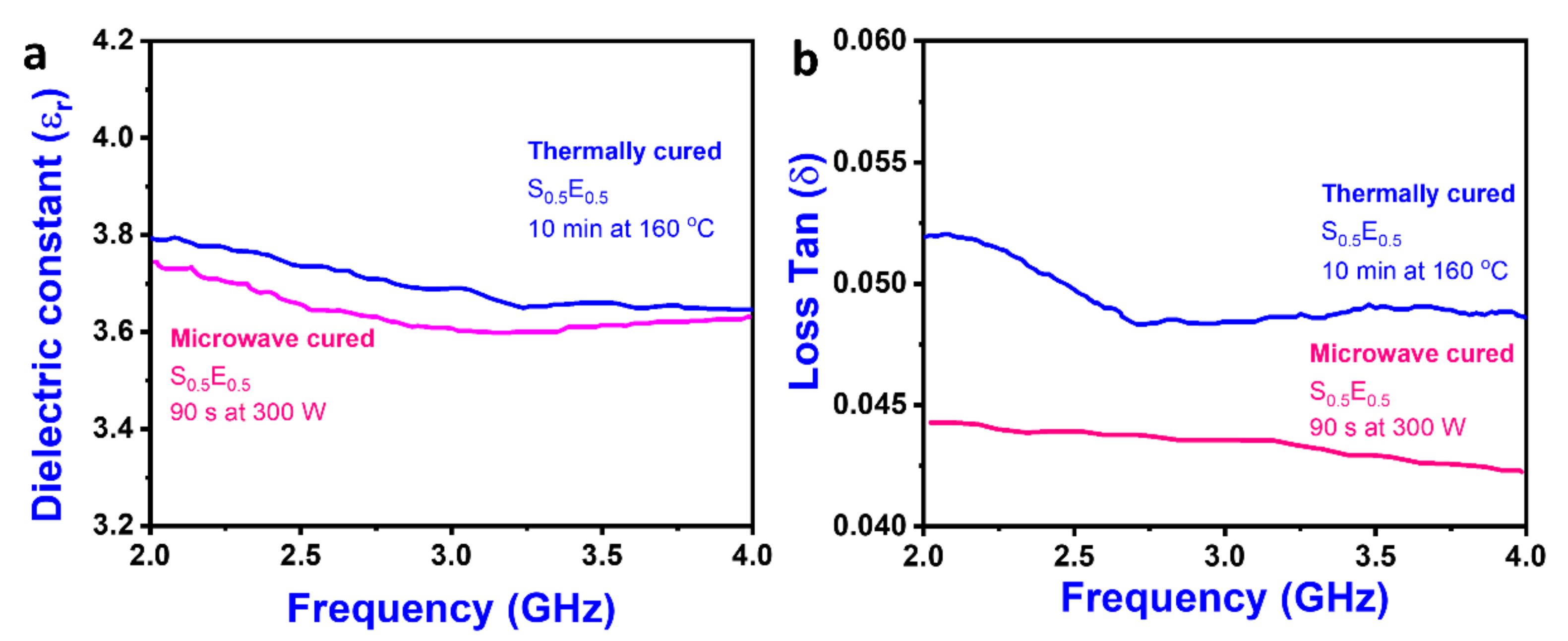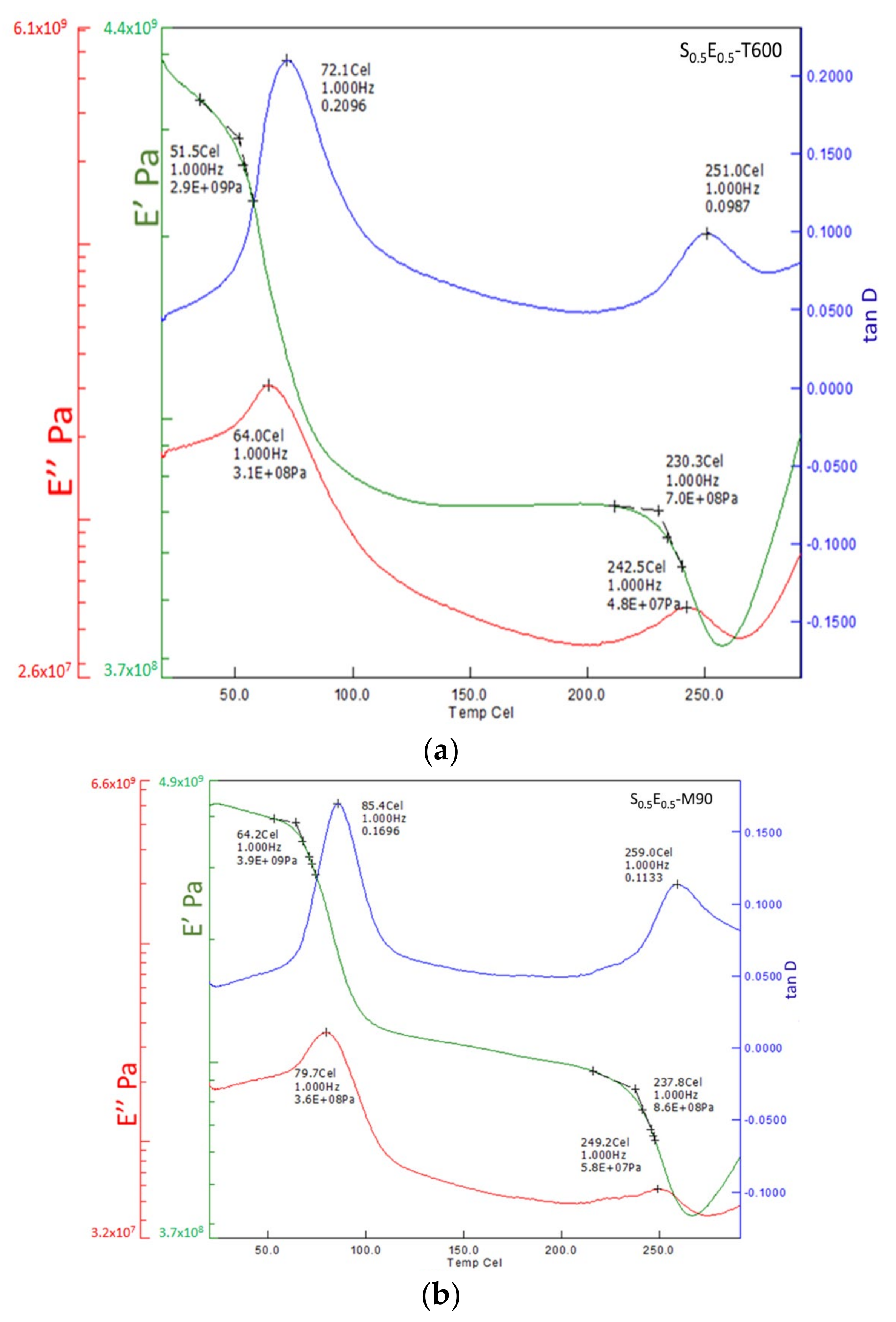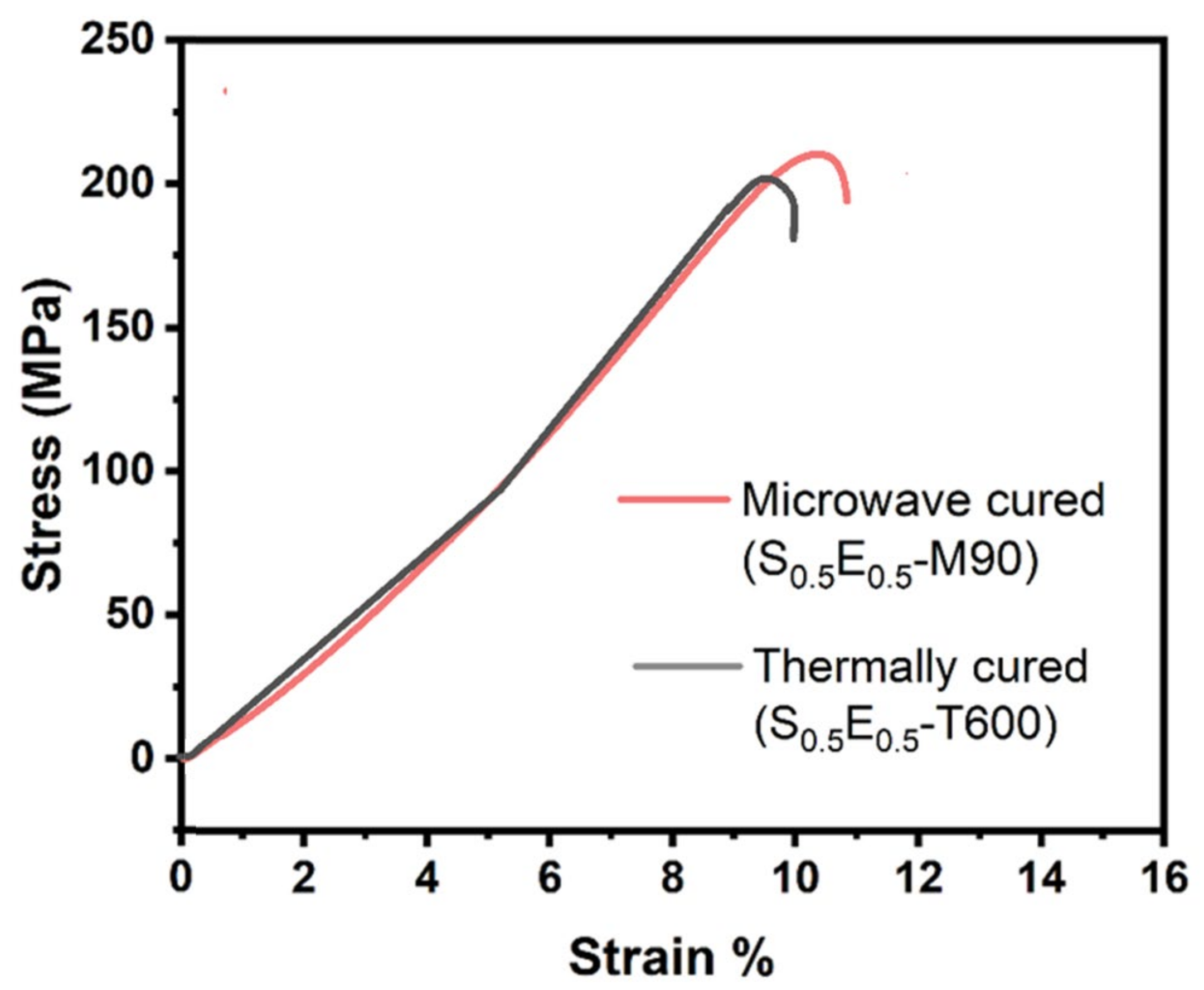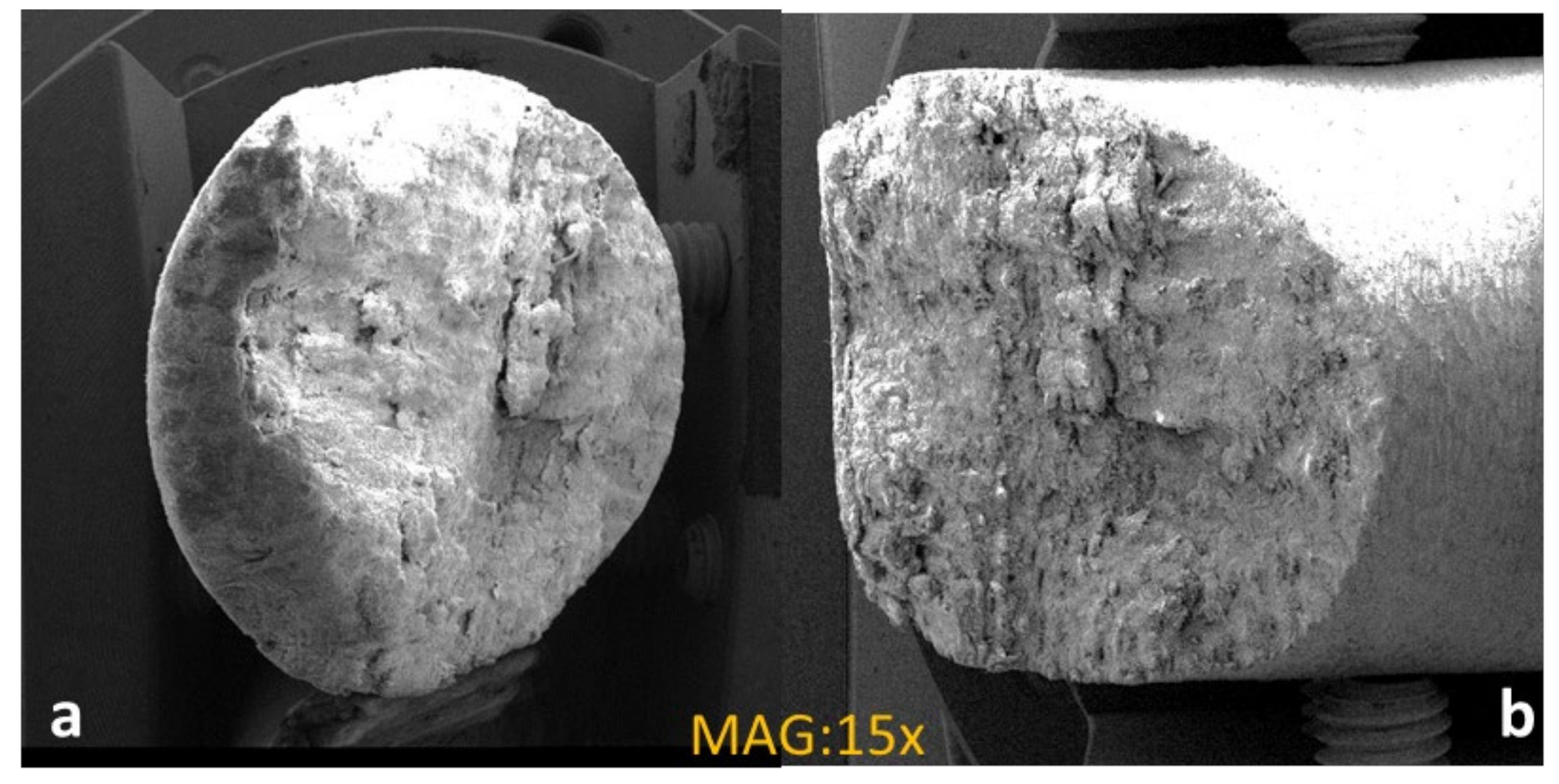Silica-Fiber-Reinforced Composites for Microelectronic Applications: Effects of Curing Routes
Abstract
1. Introduction
2. Materials and Methods
2.1. Materials
2.2. Preparation of Composite Prepregs
2.3. Curing of Composite Prepregs
2.4. Characterization
3. Results and Discussion
3.1. Dielectric Properties
3.2. Structure and Morphology
3.2.1. FTIR Analysis
3.2.2. Morphology
3.3. Thermal Properties
3.3.1. Thermogravimetric Analysis (TGA)
3.3.2. Differential Scanning Calorimeter (DSC)
3.4. Mechanical Properties
3.4.1. Dynamic Mechanical Analysis (DMA)
3.4.2. Ultimate Tensile Strength (UTS)
3.4.3. Ultimate Compression Strength (UCS)
4. Conclusions
Author Contributions
Funding
Data Availability Statement
Acknowledgments
Conflicts of Interest
References
- Kistaiah, N.; Kiran, C.U.; Reddy, G.R.; Rao, M.S. Mechanical characterization of hybrid composites: A review. J. Reinf. Plast. Compos. 2014, 33, 1364–1372. [Google Scholar] [CrossRef]
- Sathishkumar, T.P.; Satheeshkumar, S.; Naveen, J. Glass fiber-reinforced polymer composites—A review. J. Reinf. Plast. Compos. 2014, 33, 1258–1275. [Google Scholar] [CrossRef]
- Stickel, J.M.; Nagarajan, M. Glass Fiber-Reinforced Composites: From Formulation to Application. Int. J. Appl. Glass Sci. 2012, 3, 122–136. [Google Scholar] [CrossRef]
- Yıldız, S.; Karaağaç, B.; Güzeliş, S.G. Utilization of glass fiber reinforced polymer wastes. Polym. Compos. 2021, 42, 412–423. [Google Scholar] [CrossRef]
- Benedetti, A.; Fernandes, P.; Granja, J.L.; Sena-Cruz, J.; Azenha, M. Influence of temperature on the curing of an epoxy adhesive and its influence on bond behaviour of NSM-CFRP systems. Compos. Part B Eng. 2016, 89, 219–229. [Google Scholar] [CrossRef]
- Rutz, B.H.; Berg, J.C. Electrostatic deposition of silica nanoparticles between E-glass fibers and an epoxy resin. J. Appl. Polym. Sci. 2015, 132, 41516. [Google Scholar] [CrossRef]
- Godara, A.; Gorbatikh, L.; Kalinka, G.; Warrier, A.; Rochez, O.; Mezzo, L.; Luizi, F.; van Vuure, A.W.; Lomov, S.V.; Verpoest, I. Interfacial shear strength of a glass fiber/epoxy bonding in composites modified with carbon nanotubes. Compos. Sci. Technol. 2010, 70, 1346–1352. [Google Scholar] [CrossRef]
- Quinson, R.; Perez, J.; Rink, M.; Pavan, A. Components of non-elastic deformation in amorphous glassy polymers. J. Mater. Sci. 1996, 31, 4387–4394. [Google Scholar] [CrossRef]
- Budelmann, D.; Schmidt, C.; Meiners, D. Prepreg tack: A review of mechanisms, measurement, and manufacturing implication. Polym. Compos. 2020, 41, 3440–3458. [Google Scholar] [CrossRef]
- Wachsman, E.D.; Frank, C.W. Effect of cure history on the morphology of polyimide: Fluorescence spectroscopy as a method for determining the degree of cure. Polymer 1988, 29, 1191–1197. [Google Scholar] [CrossRef]
- Uddin, M.A.; Alam, M.O.; Chan, Y.C.; Chan, H.P. Adhesion strength and contact resistance of flip chip on flex packages––effect of curing degree of anisotropic conductive film. Microelectron. Reliab. 2004, 44, 505–514. [Google Scholar] [CrossRef]
- Montserrat, S.; Flaqué, C.; Pagès, P.; Málek, J. Effect of the crosslinking degree on curing kinetics of an epoxy–anhydride system. J. Appl. Polym. Sci. 1995, 56, 1413–1421. [Google Scholar] [CrossRef]
- Hart-Smith, L.J. Adhesively bonded joints in aircraft structures. In Handbook of Adhesion Technology; De Silva, L.F.M., Öchsner, A., Adams, R.D., Eds.; Springer: Berlin/Heidelberg, Germany, 2011; pp. 1103–1149. [Google Scholar]
- So, S.; Rudin, A. Effects of resin and curing parameters on the degree of cure of resole phenolic resins and woodflour composites. J. Appl. Polym. Sci. 1990, 40, 2135–2149. [Google Scholar] [CrossRef]
- Benson, R.C.; Miragliotta, J.A.; Farrar, D. Polymer adhesives and encapsulants for microelectronic applications. Johns Hopkins Apl Tech. Dig. 2008, 28, 58–71. [Google Scholar]
- Park, E.-T.; Lee, Y.; Kim, J.; Kang, B.-S.; Song, W. Experimental study on microwave-based curing process with thermal expansion pressure of PTFE for manufacturing carbon fiber/epoxy composites. Materials 2019, 12, 3737. [Google Scholar] [CrossRef]
- Mishra, R.R.; Sharma, A.K. Microwave–material interaction phenomena: Heating mechanisms, challenges and opportunities in material processing. Compos. Part A Appl. Sci. Manuf. 2016, 81, 78–97. [Google Scholar] [CrossRef]
- Liu, L.; Yi, S.; Ong, L.S.; Chian, K.S. Finite element analysis for microwave cure of underfill in flip chip packaging. Thin Solid Film. 2004, 462, 436–445. [Google Scholar] [CrossRef]
- Malik, S.; Gul, I.H.; Baig, M.M. Hierarchical MnNiCo ternary metal oxide/graphene nanoplatelets composites as high rated electrode material for supercapacitors. Ceram. Int. 2021, 47, 17008–17014. [Google Scholar] [CrossRef]
- Baig, M.M.; Gul, I.H. Transformation of wheat husk to 3D activated carbon/NiCo2S4 frameworks for high-rate asymmetrical supercapacitors. J. Energy Storage 2021, 37, 102477. [Google Scholar] [CrossRef]
- Li, N.; Li, Y.; Jelonnek, J.; Link, G.; Gao, J. A new process control method for microwave curing of carbon fibre reinforced composites in aerospace applications. Compos. Part B Eng. 2017, 122, 61–70. [Google Scholar] [CrossRef]
- Mphahlele, K.; Ray, S.S.; Kolesnikov, A. Cure kinetics, morphology development, and rheology of a high-performance carbon-fiber-reinforced epoxy composite. Compos. Part B Eng. 2019, 176, 107300. [Google Scholar] [CrossRef]
- Baig, M.M.; Gul, I.H.; Ahmad, R.; Baig, S.M.; Khan, M.Z.; Iqbal, N. One-step sonochemical synthesis of NiMn-LDH for supercapacitors and overall water splitting. J. Mater. Sci. 2021, 56, 18636–18649. [Google Scholar] [CrossRef]
- Elizbit; Liaqat, U.; Hussain, Z.; Baig, M.M.; Khan, M.A.; Arif, D. Preparation of porous ZIF-67 network interconnected by MWCNTs and decorated with Ag nanoparticles for improved non-enzymatic electrochemical glucose sensing. J. Korean Ceram. Soc. 2021, 58, 598–605. [Google Scholar] [CrossRef]
- Joshi, S.C.; Bhudolia, S.K. Microwave-thermal technique for energy and time efficient curing of carbon fiber reinforced polymer prepreg composites. J. Compos. Mater. 2014, 48, 3035–3048. [Google Scholar] [CrossRef]
- De Vergara, U.L.; Sarrionandia, M.; Gondra, K.; Aurrekoetxea, J. Polymerization and curing kinetics of furan resins under conventional and microwave heating. Thermochim. Acta 2014, 581, 92–99. [Google Scholar] [CrossRef]
- Rangari, V.; Bhuyan, M.; Jeelani, S. Microwave curing of CNFs/EPON-862 nanocomposites and their thermal and mechanical properties. Compos. Part A Appl. Sci. Manuf. 2011, 42, 849–858. [Google Scholar] [CrossRef]
- Li, A.; Li, W.; Ling, Y.; Gan, W.; Brady, M.A.; Wang, C. Effects of silica-coated carbon nanotubes on the curing behavior and properties of epoxy composites. RSC Adv. 2016, 6, 23318–23326. [Google Scholar] [CrossRef]
- Zhao, B.; Hardiman, M.; Ryan, K.M.; O’Reilly, E.; McCarthy, C. Formation of reworkable nanocomposite adhesives by dielectric heating of epoxy resin embedded Fe3O4 hollow spheres. CrystEngComm 2016, 18, 6096–6101. [Google Scholar] [CrossRef]
- Kim, N.D.; Metzger, A.; Hejazi, V.; Li, Y.; Kovalchuk, A.; Lee, S.-K.; Ye, R.; Mann, J.A.; Kittrell, C.; Shahsavari, R. Microwave heating of functionalized graphene nanoribbons in thermoset polymers for wellbore reinforcement. ACS Appl. Mater. Interfaces 2016, 8, 12985–12991. [Google Scholar] [CrossRef]
- Alfano, M.; Pagnotta, L. An investigation of the mechanical behaviour of vinyl ester resins cured by microwave irradiation. Mater. Des. 2009, 30, 4537–4542. [Google Scholar] [CrossRef]
- Yarlagadda, K.P.; Hsu, S.-H. Experimental studies on comparison of microwave curing and thermal curing of epoxy resins used for alternative mould materials. J. Mater. Process. Technol. 2004, 155, 1532–1538. [Google Scholar] [CrossRef]
- Boey, F.; Yap, B. Microwave curing of an epoxy-amine system: Effect of curing agent on the glass-transition temperature. Polym. Test. 2001, 20, 837–845. [Google Scholar] [CrossRef]
- Yao, L.; Wang, X.; Liang, F.; Wu, R.; Hu, B.; Feng, Y.; Qiu, Y. Modeling and experimental verification of dielectric constants for three-dimensional woven composites. Compos. Sci. Technol. 2008, 68, 1794–1799. [Google Scholar] [CrossRef]
- Mäder, E.; Gao, S.-L.; Plonka, R.; Wang, J. Investigation on adhesion, interphases, and failure behaviour of cyclic butylene terephthalate (CBT®)/glass fiber composites. Compos. Sci. Technol. 2007, 67, 3140–3150. [Google Scholar] [CrossRef]
- Ramajo, L.; Reboredo, M.; Castro, M. Dielectric response and relaxation phenomena in composites of epoxy resin with BaTiO3 particles. Compos. Part A Appl. Sci. Manuf. 2005, 36, 1267–1274. [Google Scholar] [CrossRef]
- Xie, H.Q.; Zhang, S.; Xie, D. An efficient way to improve the mechanical properties of polypropylene/short glass fiber composites. J. Appl. Polym. Sci. 2005, 96, 1414–1420. [Google Scholar] [CrossRef]
- Liu, Z.; Zhang, J.; Tang, L.; Zhou, Y.; Lin, Y.; Wang, R.; Kong, J.; Tang, Y.; Gu, J. Improved wave-transparent performances and enhanced mechanical properties for fluoride-containing PBO precursor modified cyanate ester resins and their PBO fibers/cyanate ester composites. Compos. Part B Eng. 2019, 178, 107466. [Google Scholar] [CrossRef]
- Zhu, L.; Wang, Z.; Rahman, M.B.; Shen, W.; Zhu, C. The Curing kinetics of e-glass fiber/epoxy resin prepreg and the bending properties of its products. Materials 2021, 14, 4673. [Google Scholar] [CrossRef]
- Fu, H.; Qin, Y.; He, X.; Meng, X.; Zhong, Y.; Zou, Z. Effect of curing degree on mechanical and thermal properties of 2.5 D quartz fiber reinforced boron phenolic composites. e-Polymers 2019, 19, 462–469. [Google Scholar] [CrossRef]
- Johnston, K.; Pavuluri, S.; Leonard, M.; Desmulliez, M.; Arrighi, V. Microwave and thermal curing of an epoxy resin for microelectronic applications. Thermochim. Acta 2015, 616, 100–109. [Google Scholar] [CrossRef]
- Spoelstra, A.; Peters, G.; Meijer, H. Chemorheology of a highly filled epoxy compound. Polym. Eng. Sci. 1996, 36, 2153–2162. [Google Scholar] [CrossRef]
- Boey, F.; Yap, B.; Chia, L. Microwave curing of epoxy-amine system—Effect of curing agent on the rate enhancement. Polym. Test. 1999, 18, 93–109. [Google Scholar] [CrossRef]
- Koushyar, H.; Alavi-Soltani, S.; Minaie, B.; Violette, M. Effects of variation in autoclave pressure, temperature, and vacuum-application time on porosity and mechanical properties of a carbon fiber/epoxy composite. J. Compos. Mater. 2012, 46, 1985–2004. [Google Scholar] [CrossRef]
- Michels, J.; Cruz, J.S.; Christen, R.; Czaderski, C.; Motavalli, M. Mechanical performance of cold-curing epoxy adhesives after different mixing and curing procedures. Compos. Part B Eng. 2016, 98, 434–443. [Google Scholar] [CrossRef]
- Ellis, B. Chemistry and Technology of Epoxy Resins; Springer: Berlin/Heidelberg, Germany, 1993. [Google Scholar]
- Endruweit, A.; Johnson, M.; Long, A. Curing of composite components by ultraviolet radiation: A review. Polym. Compos. 2006, 27, 119–128. [Google Scholar] [CrossRef]
- Rusmirović, J.; Galović, J.; Kluz, M.; Perković, S.; Brzić, S.; Bogosavljević, M.; Milojković, A.; Kovačević, T. Using potential of filament-wound carbon/glass polymeric composites as rocket motor thermal insulation. Polym. Compos. 2021, 29 (Suppl. S9), S1541–S1554. [Google Scholar] [CrossRef]
- Youssef, G.; Pessoa, G.; Nacy, S. Effect of elevated operating temperature on the dynamic mechanical performance of E-glass/epoxy composite. Compos. Part B Eng. 2019, 173, 106937. [Google Scholar] [CrossRef]












| tc | S0.3E0.7 | S0.4E0.6 | S0.5E0.5 | S0.6E0.4 | S0.7E0.3 | |||||
|---|---|---|---|---|---|---|---|---|---|---|
| (sec) | Dk | Loss | Dk | Loss | Dk | LOSS | Dk | Loss | Dk | Loss |
| 240 | 3.98 | 0.059 | 3.98 | 0.057 | 3.96 | 0.057 | 3.96 | 0.057 | 3.94 | 0.057 |
| SD | 0.006 | 0.001 | 0.010 | 0.002 | 0.0292 | 0.001 | 0.029 | 0.001 | 0.0248 | 0.002 |
| 300 | 3.96 | 0.056 | 3.97 | 0.056 | 3.95 | 0.055 | 3.95 | 0.054 | 3.91 | 0.056 |
| SD | 0.010 | 0.001 | 0.010 | 0.001 | 0.010 | 0.001 | 0.031 | 0.001 | 0.002 | 0.001 |
| 360 | 3.94 | 0.056 | 3.95 | 0.053 | 3.85 | 0.053 | 3.89 | 0.053 | 3.89 | 0.054 |
| SD | 0.010 | 0.001 | 0.010 | 0.002 | 0.048 | 0.002 | 0.039 | 0.001 | 0.027 | 0.002 |
| 420 | 3.91 | 0.053 | 3.91 | 0.055 | 3.83 | 0.053 | 3.85 | 0.053 | 3.83 | 0.053 |
| SD | 0.008 | 0.001 | 0.008 | 0.002 | 0.001 | 0.051 | 0.001 | 0.001 | 0.049 | 0.001 |
| 480 | 3.91 | 0.052 | 3.89 | 0.052 | 3.81 | 0.051 | 3.82 | 0.052 | 3.79 | 0.052 |
| SD | 0.014 | 0.001 | 0.019 | 0.001 | 0.001 | 0.001 | 0.010 | 0.001 | 0.025 | 0.002 |
| 600 | 3.90 | 0.053 | 3.89 | 0.054 | 3.80 | 0.050 | 3.82 | 0.051 | 3.78 | 0.052 |
| SD | 0.014 | 0.001 | 0.015 | 0.001 | 0.061 | 0.001 | 0.001 | 0.001 | 0.014 | 0.001 |
| 660 | 3.90 | 0.053 | 3.98 | 0.054 | 3.79 | 0.051 | 3.80 | 0.051 | 3.94 | 0.052 |
| SD | 0.018 | 0.001 | 0.002 | 0.012 | 0.002 | 0.008 | 0.002 | 0.001 | 0.010 | 0.001 |
| tc | S0.3E0.7 | S0.4E0.6 | S0.5E0.5 | S0.6E0.4 | S0.7E0.3 | |||||
|---|---|---|---|---|---|---|---|---|---|---|
| (sec) | Dk | Loss | Dk | Loss | Dk | Loss | Dk | loss | Dk | Loss |
| 20 | 3.98 | 0.050 | 3.96 | 0.051 | 3.92 | 0.048 | 3.94 | 0.048 | 3.94 | 0.048 |
| SD | 0.023 | 0.001 | 0.012 | 0.005 | 0.005 | 0.002 | 0.008 | 0.002 | 0.009 | 0.003 |
| 30 | 3.89 | 0.049 | 3.89 | 0.049 | 3.89 | 0.046 | 3.90 | 0.047 | 3.93 | 0.046 |
| SD | 0.042 | 0.001 | 0.027 | 0.003 | 0.020 | 0.003 | 0.020 | 0.001 | 0.024 | 0.002 |
| 45 | 3.86 | 0.048 | 3.85 | 0.048 | 3.85 | 0.045 | 3.86 | 0.045 | 3.88 | 0.046 |
| SD | 0.036 | 0.001 | 0.013 | 0.001 | 0.043 | 0.004 | 0.029 | 0.002 | 0.034 | 0.002 |
| 60 | 3.84 | 0.048 | 3.82 | 0.046 | 3.82 | 0.044 | 3.82 | 0.043 | 3.84 | 0.043 |
| SD | 0.026 | 0.002 | 0.026 | 0.001 | 0.026 | 0.00 | 0.009 | 0.002 | 0.034 | 0.002 |
| 75 | 3.80 | 0.046 | 3.79 | 0.045 | 3.78 | 0.043 | 3.79 | 0.042 | 3.80 | 0.043 |
| SD | 0.017 | 0.001 | 0.030 | 0.002 | 0.053 | 0.004 | 0.036 | 0.002 | 0.045 | 0.001 |
| 90 | 3.81 | 0.046 | 3.80 | 0.045 | 3.77 | 0.043 | 3.79 | 0.043 | 3.80 | 0.043 |
| SD | 0.041 | 0.003 | 0.026 | 0.001 | 0.060 | 0.002 | 0.023 | 0.002 | 0.028 | 0.003 |
| 100 | 3.80 | 0.046 | 3.80 | 0.051 | 3.78 | 0.043 | 3.79 | 0.041 | 3.80 | 0.042 |
| SD | 0.045 | 0.004 | 0.038 | 0.002 | 0.033 | 0.003 | 0.027 | 0.002 | 0.046 | 0.002 |
Disclaimer/Publisher’s Note: The statements, opinions and data contained in all publications are solely those of the individual author(s) and contributor(s) and not of MDPI and/or the editor(s). MDPI and/or the editor(s) disclaim responsibility for any injury to people or property resulting from any ideas, methods, instructions or products referred to in the content. |
© 2023 by the authors. Licensee MDPI, Basel, Switzerland. This article is an open access article distributed under the terms and conditions of the Creative Commons Attribution (CC BY) license (https://creativecommons.org/licenses/by/4.0/).
Share and Cite
Haider, I.; Gul, I.H.; Umer, M.A.; Baig, M.M. Silica-Fiber-Reinforced Composites for Microelectronic Applications: Effects of Curing Routes. Materials 2023, 16, 1790. https://doi.org/10.3390/ma16051790
Haider I, Gul IH, Umer MA, Baig MM. Silica-Fiber-Reinforced Composites for Microelectronic Applications: Effects of Curing Routes. Materials. 2023; 16(5):1790. https://doi.org/10.3390/ma16051790
Chicago/Turabian StyleHaider, Imran, Iftikhar Hussain Gul, Malik Adeel Umer, and Mutawara Mahmood Baig. 2023. "Silica-Fiber-Reinforced Composites for Microelectronic Applications: Effects of Curing Routes" Materials 16, no. 5: 1790. https://doi.org/10.3390/ma16051790
APA StyleHaider, I., Gul, I. H., Umer, M. A., & Baig, M. M. (2023). Silica-Fiber-Reinforced Composites for Microelectronic Applications: Effects of Curing Routes. Materials, 16(5), 1790. https://doi.org/10.3390/ma16051790






